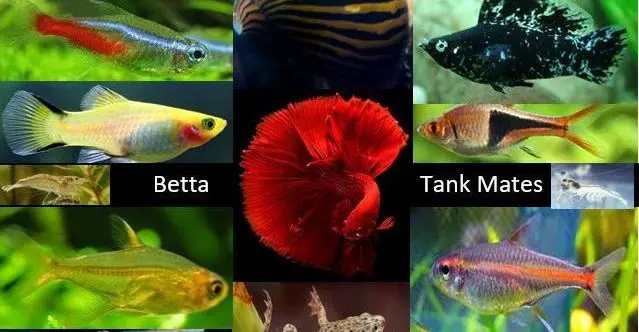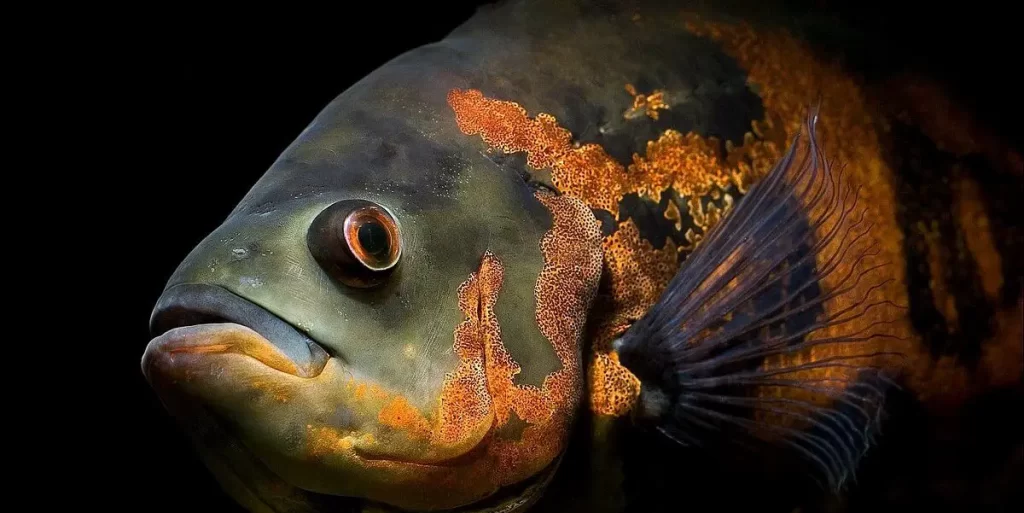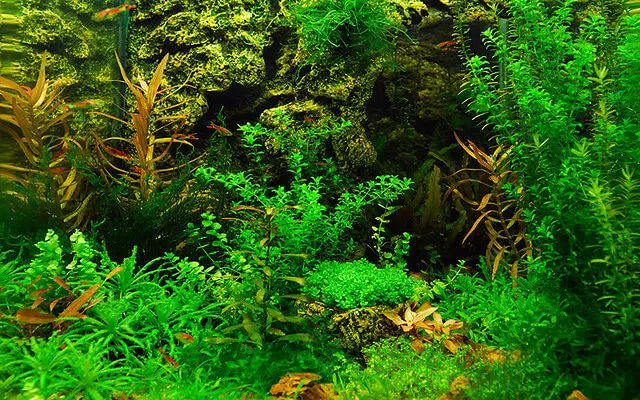While Betta fish can survive in a tank, adding compatible tank mates can help create a more natural and interesting environment for your fish. These fish are known for their beauty and unique personality but can be aggressive towards certain fish. Therefore, choosing the right tank mates is important to keep everyone happy and healthy.
When adding tank mates to your Betta fish tank, choose fish that get along well and won’t cause problems. Suitable options include neon tetras, glowlight tetras, ember tetras, and bottom-dwelling fish like Corydoras catfish. These fish have peaceful temperaments and can thrive in similar water conditions. You should provide enough space and hiding spots in the aquarium to ensure each fish has territory.
Do Betta Fish Need Tank Mates?
Betta Fish can be happy and content living alone in their little kingdom. They don’t necessarily need tank mates to survive. However, introducing tank mates can be wonderful if you want to add excitement and variety to your tank. You should choose compatible tank mates for your Betta Fish with similar water requirements, peaceful temperaments, and appropriate sizes to create a harmonious and stress-free environment.
Adding tank mates to your betta fish’s tank can also allow you to explore and learn about different fish species, expanding your knowledge and experience in fish keeping. In addition, you can watch your betta interact with other fish, which is fascinating. Just be sure to choose the right tank mates that will get along well with your betta and won’t cause any conflicts in the tank.
Tips For Choosing Betta Tank Mates
Every Betta fish is unique, so just because someone else successfully kept fancy guppies as tank mates don’t mean it will work for you. If you want to house other fish with your Betta, buy a larger tank, such as a 40-gallon tank, as Bettas are territorial and require more space. Here are some tips that will help you set up a Betta tank properly:
- Size Of Tank: The minimum tank size for a single betta is 5 gallons, but if you want to add tank mates, you’ll need a larger tank, at least 20-gallon. Here is a guide to setting up a betta tank properly.
- Water Parameter: Keep those fish species that require water parameters the same as betta needs. I have written an article on Betta Fish Diseases And How To Treat Them to learn more about their diseases. You can check out the article by clicking on the link.
- Fish Temperament: Bettas are known for being aggressive and territorial towards some fish species, so choosing peaceful fish that won’t stimulate the betta is important.
- Male vs. Female Bettas: Male Bettas are more aggressive and territorial than female bettas, which makes them less suitable for community tanks.
What Is The Ideal Tank Size for Betta Fish with Other Species?
If you plan to introduce other fish to your betta’s tank, it’s important to consider the tank size first. For example, a 5-gallon tank is suitable for housing snails or other small invertebrates as tank mates for bettas. However, if you intend to add other fish species, a larger tank is required, preferably 10 to 40 gallons. A general guideline is to provide one gallon of water per inch of fish when determining the tank size for bettas and their tank mates.
Betta fish are naturally territorial and can become aggressive when their space feels threatened. The number of fish you add will determine the required tank size, as more fish buddies need a larger tank. Having extra space in the tank is beneficial, but overcrowding fish in a small tank can negatively impact water quality and trigger territorial behavior in your betta. Additionally, you should ensure plenty of covers and live plants in the tank to prevent your betta from attacking other fish.
What Factors Should I Consider While Choosing Tank Mates for My Betta Fish?
When it comes to choosing tank mates for your Betta fish, there are several factors you should consider to ensure compatibility and a harmonious aquarium environment. Here are some of the essential factors that you should consider while choosing tank mates for your betta fish:
1. Temperament
As we have already discussed how aggressive betta fish can be, so it’s very crucial to get a peaceful fish as a tank mate. Some peaceful tank mates for Betta fish include tetras, Corydoras catfish, gouramis, and snails. Introducing aggressive or territorial fish as tank mates can result in aggressive behaviors, leading to injury or death for the Betta and other fish in the aquarium.
2. Size Of The Fish
When choosing tank mates for your Betta fish, consider selecting fish species with a similar or slightly smaller size. Larger fish may see the Betta as a threat or competition, leading to aggression and possible harm.
Additionally, if the tank mates are too small, the Betta may see them as prey and exhibit predatory behavior. Therefore, keeping a balanced size ratio among the tank mates promotes a peaceful and harmonious coexistence in the aquarium.
3. Swimming Habits
Bettas like slow swimming in calm waters, so it’s ideal to select fish that have similar swimming behaviors and prefer similar water conditions. Fish like dwarf gouramis or cherry barbs exhibit a similarly slow and graceful swimming style, making them compatible with Betta tank mates. These species also live in similar water parameters, including temperature and pH.
Learn: Why Does pH Level Affect Betta Fish?
4. Diet
Bettas are carnivores and prefer a protein-rich diet. They are competitive eaters, so it’s important to choose tank mates that won’t compete for the same types of food or require different diets.
For example, choosing herbivorous fish like platies or mollies, which primarily feed on plant matter, can be a suitable option as they won’t directly compete with the Betta for the same types of food. Here is a full article on What To Feed Your Betta Fish, where I have detailed their dietary requirements.
5. Compatibility
Some fish may not be compatible with Bettas due to their aggressive nature. Avoid adding fish like tiger barbs that are small but aggressive and may nip at the colorful and long-finned Betta fish. Similarly, male guppies, being slow fish, may be targeted by Betta and should be avoided as tank mates.
On the other hand, peaceful fish like mollies, swordtails, or celestial pearl danios are more likely to live harmoniously with Bettas. Therefore, researching and selecting compatible tank mates is important to ensure a healthy, happy, and stress-free environment for all the fish.
6. Tank size
The size of your aquarium is important when choosing tank mates for your Betta. Ensure your aquarium is big enough to give each fish space to swim and establish its territory. This will help prevent any fights and promote a peaceful environment. In a 10-15 gallon betta tank, you can consider adding tank mates like neon tetras or Corydoras catfish, as they are small and don’t require excessive swimming space.
21 Best Betta Fish Tank Mates
Several peaceful fish options are available if you want to add tank mates for your betta fish in a community tank. The mentioned fish are gentle and won’t attack or harm your betta fish. Additionally, they tend to coexist well with bettas without causing any interference. Here I have compiled a list of fish that can be suitable tank mates for your betta, which makes a peaceful and harmonious aquarium environment:
Tetra Fish

Tetra is small freshwater fish known for their bright colors and active swimming. They have sleek bodies with shiny scales in various colors like red, blue, green, and silver. Tetras are peaceful and live well with other fish in a community aquarium.
They need a tank with enough space to swim and places to hide, like plants, rocks, or driftwood. However, not all tetras are good tank mates for betta fish, so here are some of the tetra fish that can peacefully coexist with your betta fish are:
Neon Tetras
Neon tetras are beautiful fish with bright blue and red stripes on their bodies. They have a slender and streamlined body shape, and their abdomen is silver. These tetras add a stunning touch to any aquarium with their vibrant colors and graceful swimming.
One important aspect to consider when caring for neon tetras is their schooling behavior. These tetras thrive when kept in groups, preferably consisting of 6 to 8 individuals or more. To accommodate their social nature, providing more swimming space and adding plenty of plants into the tank is crucial. The plants serve as both hiding places and visual barriers, creating a comfortable environment for them to live.

- Scientific name: Paracheirodon innesi
- Adult Size: Up to 1.5 inches (3.8 cm)
- Minimum Tank Size: At least 10 gallons
- Level: Beginners
- Compatibility: Peaceful and compatible with other small, non-aggressive fish such as other tetras, guppies, and rasboras
- Care Level: Easy
- Water Temperature: 72-78°F (22-26°C)
- Diet: Omnivorous; they will eat a variety of foods, including flake food, small pellets, frozen or live foods such as brine shrimp or daphnia
- Origin: South America, specifically the Amazon Basin
- Swimming Level: Middle to top of the aquarium, but will also swim throughout the tan
Glowlight Tetras
Glowlight Tetras are beautiful freshwater fish known for their distinctive orange-red body and shiny gold stripe. Although bettas may be attracted to the glowing stripe, you don’t need to worry as these tetras are super fast swimmers and can easily prevent betta attacks.
These tetras prefer a well-planted tank with plenty of hiding spots and visual barriers, adding an amazing glow throughout the aquarium. In addition, they are very social and prefer to swim together in groups of at least six or more.
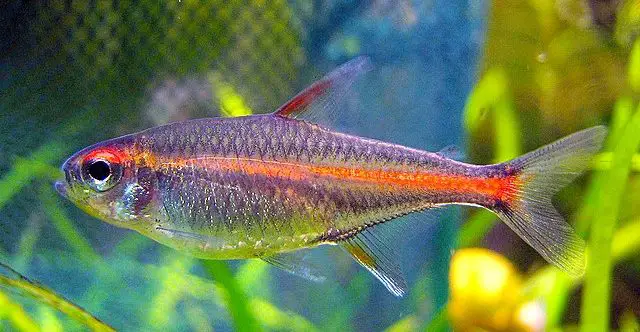
- Scientific name: Hemigrammus erythrozonus
- Adult Size: Up to 1.5 inches (3.8 cm)
- Minimum Tank Size: At least 10 gallons
- Level: Beginners
- Compatibility: Peaceful and compatible with other small, non-aggressive fish such as other tetras, guppies, and rasboras
- Care Level: Easy
- Water Temperature: 72-82°F (22-28°C)
- Diet: Omnivorous; they will eat a variety of foods, including flake food, small pellets, frozen or live foods such as brine shrimp or daphnia
- Origin: South America, specifically the Essequibo River and the Mazaruni River in Guyana
- Swimming Level: Middle to top of the aquarium, but will also swim throughout the tank.
Ember Tetras
Ember tetras are relatively small fish with a slim body shape and see-through fins, giving them a delicate and elegant look. They prefer aquariums with dense vegetation, as it provides hiding places and mimics their natural habitat.
One of the best things about Ember Tetras is that they prefer to stay in the mid-section of the tank, while bettas often hang out at the top. These fish are best kept in schools of at least six individuals to create a sense of security and to showcase their energetic and active behavior.
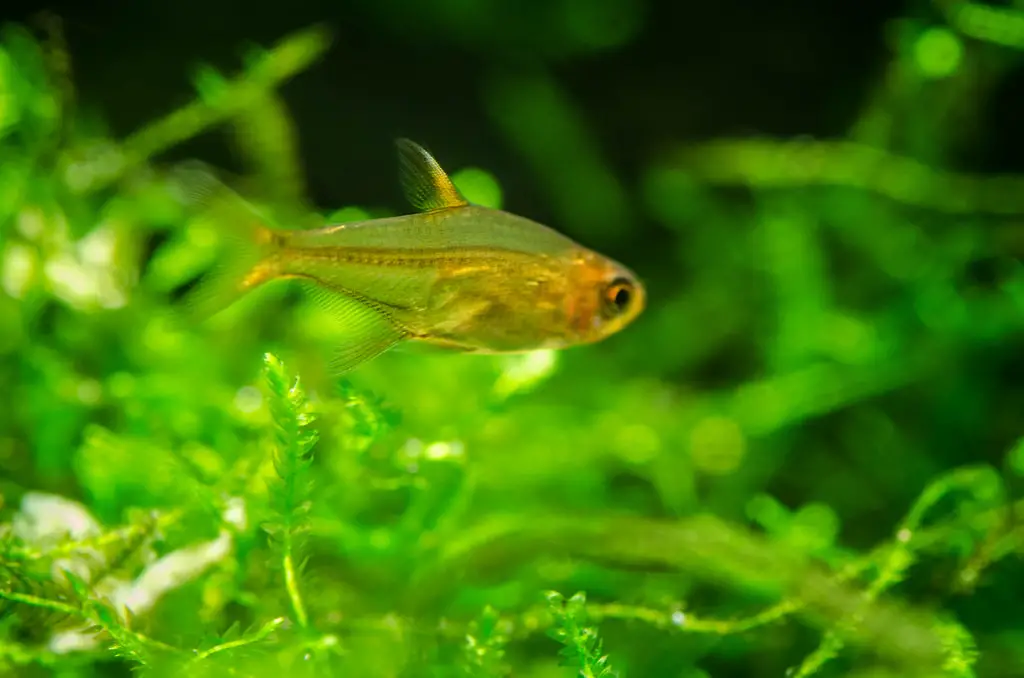
- Scientific name: Hyphessobrycon amandae
- Adult Size: Up to 0.8 inches (2 cm)
- Minimum Tank Size: At least 5 gallons
- Level: Beginners
- Compatibility: Peaceful and compatible with other small, non-aggressive fish such as tetras, guppies, and rasboras. They can also be kept in a species-only tank.
- Care Level: Easy
- Water Temperature: 72-82°F (22-28°C)
- Diet: Omnivorous; they will eat various foods, including flake food, small pellets, and frozen or live foods such as brine shrimp or daphnia. They have small mouths, so they require small food items.
- Origin: South America, specifically the Araguaia River basin in Brazil
- Swimming Level: Middle to top of the aquarium, but will also swim throughout the tank.
Cardinal Tetras
Cardinal tetras are colorful fish with slender bodies with bright red and shiny blue stripes running along their sides. The combination of these vibrant colors creates a stunning display in the aquarium.
Keeping Cardinal in a group of at least six individuals is recommended to ensure their well-being and reduce stress. Additionally, these tetras are incredibly fast swimmers and prefer a tank with more swimming space and plenty of vegetation, such as live plants, to mimic their natural habitat.
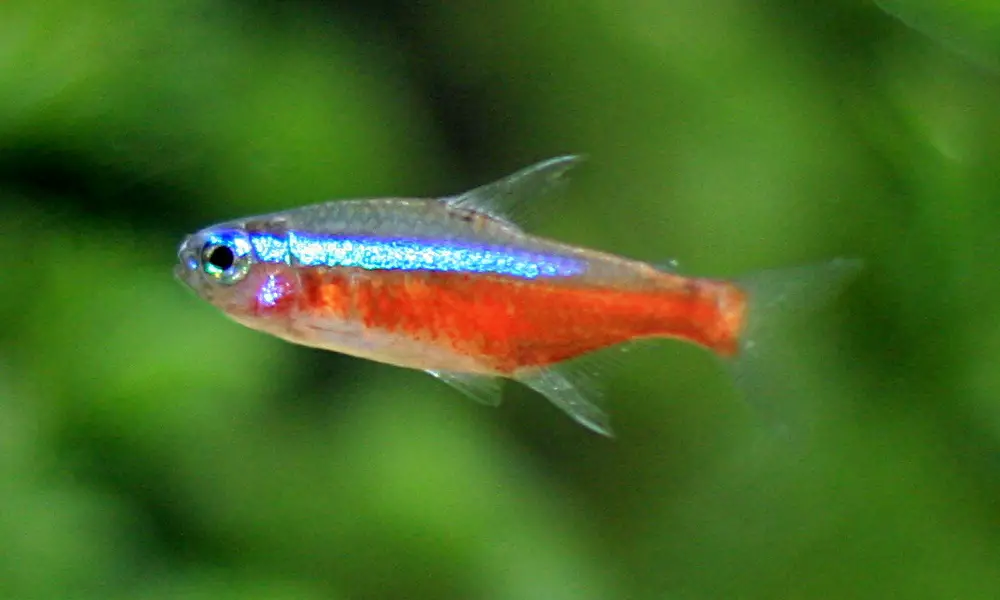
- Scientific name: Paracheirodon axelrodi
- Adult Size: Up to 2 inches (5 cm)
- Minimum Tank Size: At least 20 gallons
- Level: Beginners
- Compatibility: Peaceful and compatible with other small, non-aggressive fish such as tetras, guppies, and rasboras. They can also be kept with larger, peaceful fish such as angelfish and discus.
- Care Level: Moderate
- Water Temperature: 72-82°F (22-28°C)
- Diet: Omnivorous; they will eat a variety of foods, including flake food, small pellets, frozen or live foods such as brine shrimp or daphnia
- Origin: South America, specifically the upper Orinoco and Negro rivers in Venezuela, Colombia, and Brazil
- Swimming Level: Middle to top of the aquarium, but will also swim throughout the tank.
Rummy Nose Tetras
Rummy Nose Tetras are famous for their eye-catching look with a special red marking on their nose that stretches across their face horizontally. The rest of their body is silver with a black wedge-shaped spot near the tail fin.
To mimic their natural habitat, these tetras prefer a well-maintained aquarium with plenty of swimming space, dense vegetation, and gentle water flow. These tetras also live in groups, so keeping them in schools of at least six individuals is recommended.

- Scientific name: Hemigrammus rhodostomus
- Adult Size: Up to 2 inches (5 cm)
- Minimum Tank Size: At least 20 gallons
- Level: Beginners
- Compatibility: Peaceful and compatible with other small, non-aggressive fish such as tetras, guppies, and rasboras. They can also be kept with larger, peaceful fish such as angelfish and discus.
- Care Level: Easy
- Water Temperature: 75-82°F (24-28°C)
- Diet: Omnivorous; they will eat various foods, including flake food, small pellets, and frozen or live foods such as brine shrimp or daphnia.
- Origin: South America, specifically the Amazon Basin, Essequibo River, and Rio Negro in Brazil, Guyana, and Venezuela
- Swimming Level: Middle to top of the aquarium, but will also swim throughout the tank.
Silver Tip Tetras
Silver Tip Tetras are small, peaceful freshwater fish known for their sleek and elongated body shape. They have a silver-colored body with distinct black markings on their dorsal fin, which gives them an eye-catching appearance.
Like other tetras, Silver Tip Tetras are also schooling fish and should be kept in groups of at least six individuals for their well-being and natural behavior. They prefer a well-planted aquarium with plenty of swimming space, and they appreciate the presence of driftwood and rocks to mimic their natural habitat.
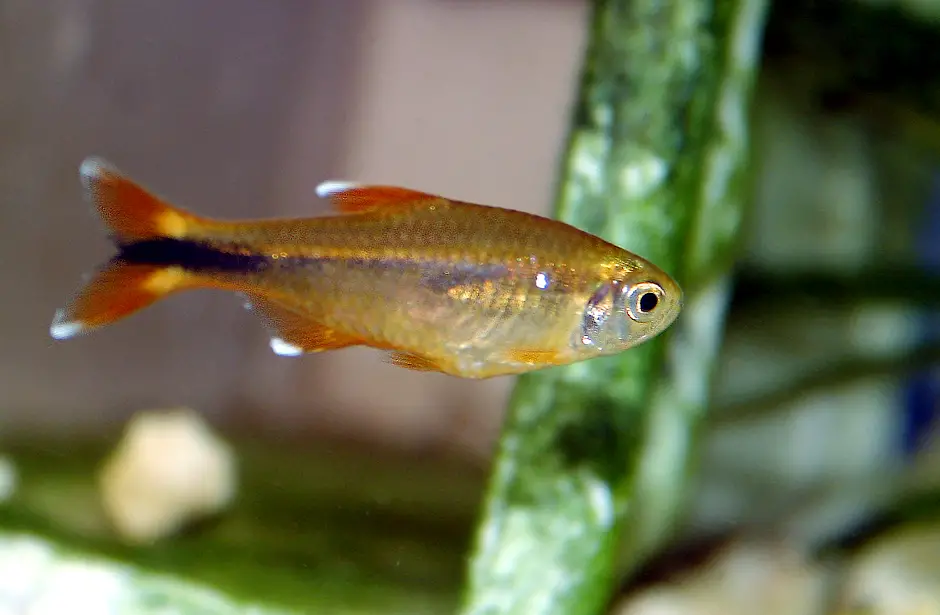
- Scientific name: Hasemania nana
- Adult size: Up to 2 inches (5 cm)
- Minimum Tank Size: 10 gallons
- Level: Beginners
- Compatibility: Generally peaceful and can be kept with other peaceful community fish
- Care level: Easy
- Water Temperature: 72-82 degrees Fahrenheit (22-28 degrees Celsius)
- Diet: Omnivorous; they eat a variety of small live or frozen foods, as well as high-quality flake or pellet foods
- Origin: South America (Brazil, Paraguay, Argentina)
- Swimming Level: Middle to the top level of the aquarium
Bottom-Dwelling Fish
Bottom Dwellers are a group of fish species that have adapted to live and explore the lower regions of the aquarium. They typically have specialized features such as flattened bodies, downward-facing mouths, and strong pectoral fins that aid their bottom-dwelling behavior.
Additionally, bottom dwellers are excellent cleaners, as they naturally adapt to search for leftover foods and waste in the substrate. Therefore, these fish species require a suitable substrate, such as sand or smooth gravel, that allows them to dig and explore comfortably.
Also, provide hiding places such as caves, plants, or driftwood to create a secure and stimulating environment for bottom dwellers. Some of the bottom-dwelling fish are as follows:
Otocinclus Catfish
Otocinclus catfish are peaceful and social fish that are often found in groups. They have a unique appearance: slender bodies, tough plates, and sucker-like mouths. Their coloration is typically brownish or olive, which helps them blend in with their natural environment. They prefer well-planted aquariums with plenty of hiding spots and gentle water flow. Also, they are highly valued for their ability to eat algae, making them great additions to aquariums.
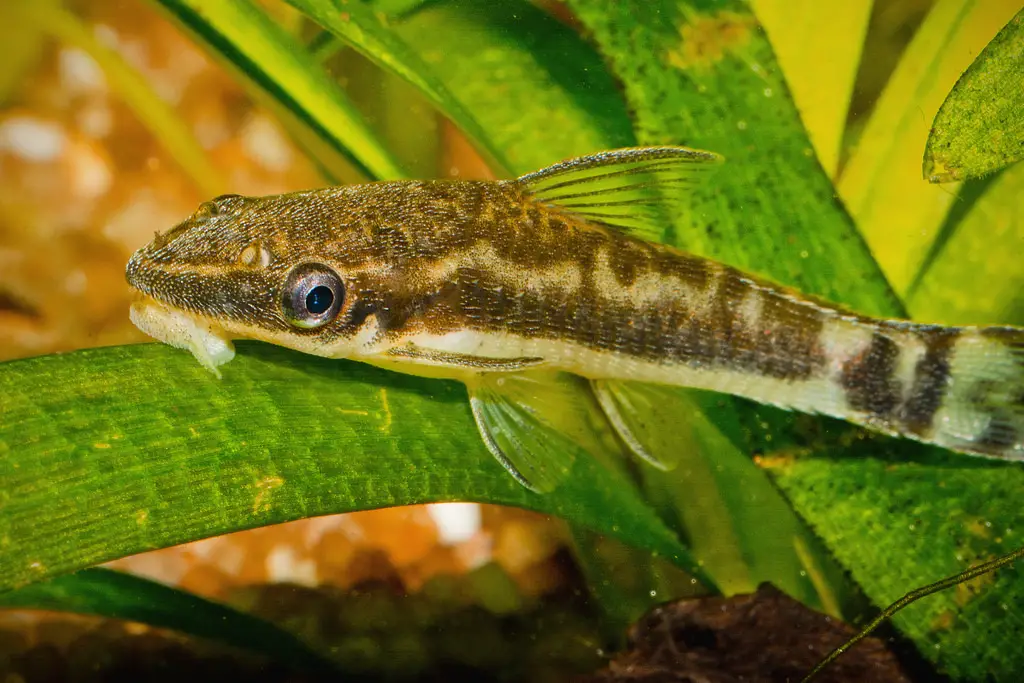
- Scientific name: Otocinclus arnoldi
- Adult Size: Up to 2 inches (5 cm)
- Minimum Tank Size: At least 10 gallons
- Level: Beginners
- Compatibility: Peaceful and compatible with other small, non-aggressive fish such as tetras, rasboras, and guppies. They can also be kept with other small bottom-dwelling fish like corydoras and shrimp.
- Care Level: Easy
- Water Temperature: 72-78°F (22-26°C)
- Diet: Herbivorous; they require a diet high in algae, so supplementing their diet with algae wafers, blanched vegetables, and spirulina-based foods is recommended.
- Origin: South America, specifically the Amazon Basin in Brazil, Peru, and Ecuador
- Swimming Level: Bottom of the aquarium; they are excellent algae eaters and will spend most of their time grazing on surfaces such as driftwood, rocks, and plants.
Kuhli Loaches
Kuhli Loaches are bottom-dwelling freshwater fish with long and slender bodies with a snake-like appearance. They have a unique and fascinating appearance with dark bands or stripes on their pale or yellowish body.
These kuhli loaches make great tankmates for bettas because they spend a lot of time hiding in the substrate. However, they’re not flashy fish, so your betta might not notice them in a fish tank.
Kuhli loaches live in aquariums with hiding spots like caves, driftwood, and plants. They prefer a sandy or fine-gravel substrate and enjoy a well-planted tank with low to moderate lighting.

- Scientific name: Pangio kuhlii
- Adult Size: Up to 4 inches (10 cm)
- Minimum Tank Size: At least 20 gallons
- Level: Beginners
- Compatibility: Peaceful and compatible with other small, non-aggressive fish such as tetras, rasboras, and guppies. They can also be kept with other bottom-dwelling fish like corydoras and shrimp.
- Care Level: Moderate
- Water Temperature: 75-86°F (24-30°C)
- Diet: Omnivorous; they will eat various foods, including sinking pellets, frozen or live foods such as brine shrimp or bloodworms, and algae-based foods.
- Origin: Southeast Asia, specifically the island of Java and surrounding areas.
- Swimming Level: Bottom of the aquarium; they are known for their wriggling and burrowing behavior and will spend most of their time hiding among plants and other decorations on the tank bottom.
Corydoras Catfish
Corydoras catfish are popular among aquarium enthusiasts due to their unique appearance. They have a compact body, a downward-facing mouths, and a series of bony plates covering their bodies, giving them a shielded look. You can find them in various colors and patterns, including albino, bronze, and peppered.
These catfish are adorable, easy to care for, and they clean up leftover food and debris from the tank’s substrate. Regarding tank requirements, Corydoras live in aquariums with a sandy substrate to protect their delicate sensory organ. In addition, they prefer a well-planted tank with plenty of hiding spots, such as caves, driftwood, and plants. Also, they are social creatures and should be kept in groups of at least six individuals.

- Scientific name: Corydoras spp
- Adult Size: Depending on the species, they can range from 1-4 inches (2.5-10 cm)
- Minimum Tank Size: At least 10 gallons, but larger tanks are recommended for multiple individuals.
- Level: Beginners
- Compatibility: Peaceful and compatible with other small, non-aggressive fish such as tetras, rasboras, and guppies. They can also be kept with other small bottom-dwelling fish like loaches and shrimp.
- Care Level: Easy
- Water Temperature: 72-80°F (22-27°C)
- Diet: Omnivorous; they will eat various foods, including sinking pellets, frozen or live foods such as brine shrimp or bloodworms, and algae-based foods.
- Origin: South America, specifically the Amazon Basin in Brazil, Peru, and Colombia.
- Swimming Level: Bottom of the aquarium; they are active and will spend most of their time scavenging along the substrate for food. They also enjoy resting on plants and decorations.
Albino Corydoras
The Albino Corydoras is a popular variant of the Corydoras catfish known for its distinctive appearance and peaceful nature. These catfish have a compact body with a downward-facing mouth and a series of bony plates covering them, similar to other Corydoras species.
However, what sets the Albino Corydoras apart is its unique coloration. They lack pigmentation and have a pale or white body coloration with bright red eyes. These catfish prefer a well-planted aquarium with plenty of hiding spots, such as caves, driftwood, and plants, and a sandy substrate to protect their delicate sensory organs.
Being bottom dweller fish, people with albinism spend most of their time searching for food and cleaning up any waste on the bottom of the tank. Also, their unique albino coloration can add a striking contrast to your tank’s overall aesthetic.

- Scientific name: Corydoras paleatus (Albino variant)
- Adult Size: Up to 3 inches (7.5 cm)
- Minimum Tank Size: At least 10 gallons, but larger tanks are recommended for multiple individuals.
- Level: Beginners
- Compatibility: Peaceful and compatible with other small, non-aggressive fish such as tetras, rasboras, and guppies. They can also be kept with other small bottom-dwelling fish like loaches and shrimp.
- Care Level: Easy
- Water Temperature: 72-80°F (22-27°C)
- Diet: Omnivorous; they will eat various foods, including sinking pellets, frozen or live foods such as brine shrimp or bloodworms, and algae-based foods.
- Origin: South America, specifically the Paraguay and Paraná river basins in Brazil and Argentina.
- Swimming Level: Bottom of the aquarium; they are active and will spend most of their time scavenging along the substrate for food.
Dwarf Plecos
Dwarf Plecos are small, interesting fish with a special, eye-catching look. They have tough bodies covered in hard plates, giving them a strong and rugged appearance. These plecos can be found in different colors, like brown, black, or even have spots.
It’s best to have plants and not too bright lights for the tank. These dwarf plecos like to have many places to hide in their aquarium, such as caves, rocks, or driftwood. They feel safe and comfortable when they have these hiding spots. A sandy or fine-gravel bottom in the tank is also good, reminding them of their natural habitat.
One thing that makes plecos so great is their ability to eat algae and keep the tank clean. This is a huge help in maintaining a healthy environment for your betta fish.
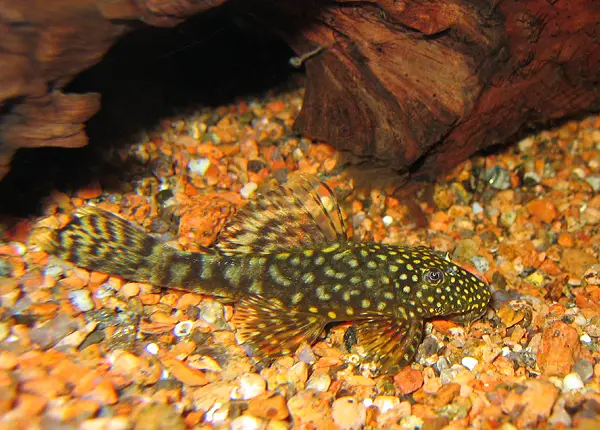
- Scientific name: Bristlenose pleco (Ancistrus sp.)
- Adult Size: Depending on the species, they can range from 2-4 inches (5-10 cm)
- Minimum Tank Size: At least 20 gallons, but larger tanks are recommended for multiple individuals
- Level: Beginners
- Compatibility: Generally peaceful and compatible with other small, non-aggressive fish. However, they may become territorial towards other bottom-dwelling fish and should be kept with fish of similar size and temperament.
- Care Level: Moderate
- Water Temperature: 72-82°F (22-28°C), depending on the species
- Diet: Omnivorous; they will eat various foods, including sinking pellets, frozen or live foods such as brine shrimp or bloodworms, and algae-based foods. Some species may also require wood in their diet to aid in digestion.
- Origin: Various locations in South America, including Brazil, Colombia, and Peru
- Swimming Level: Bottom of the aquarium; they are active and will spend most of their time scavenging along the substrate for food.
Rasbora
Rasboras are small and colorful freshwater fish known for their active swimming behavior. They have a streamlined body shape and come in vibrant colors such as silver, gold, or red, adding beauty to any aquarium.
These rasbora fish prefer an aquarium with floating plants or tall vegetation that provides shade and cover. They are peaceful fish and can be kept in groups, so a larger tank with free swimming space is recommended. So, here are some of the Rasbora fish which is compatible with betta fish:
Harlequin Rasboras
Harlequin Rasboras are popular freshwater fish known for their colorful body and peaceful nature. They have a slim and compact body shape with a silver-colored abdomen and striking black and orange markings on their sides. These markings resemble a harlequin pattern, which gives them their name.
If you’re considering adding Harlequin Rasboras to your betta tank, remember that they’re shoaling fish and must be kept in groups of at least six. These rasboras prefer a well-planted aquarium with plenty of swimming space. In addition, they appreciate the presence of hiding spots and visual barriers, such as caves, rocks, and dense vegetation.
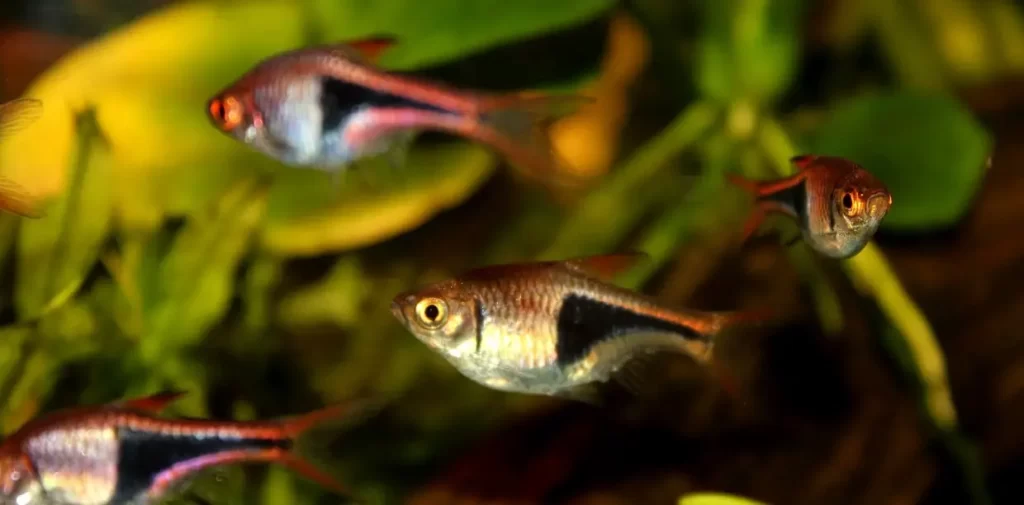
- Scientific name: Trigonostigma heteromorpha
- Adult Size: Up to 2 inches (5 cm)
- Minimum Tank Size: At least 10 gallons, but larger tanks are recommended for a school of 6 or more individuals.
- Level: Beginners
- Compatibility: Peaceful and compatible with other small, non-aggressive fish such as tetras, guppies, and corydoras. They may become stressed in the presence of aggressive or larger fish.
- Care Level: Easy
- Water Temperature: 72-80°F (22-27°C)
- Diet: Omnivorous; they will eat various foods, including flakes, pellets, frozen or live foods such as brine shrimp or bloodworms, and small insects and crustaceans.
- Origin: Southeast Asia, specifically Thailand, Malaysia, and Indonesia
- Swimming Level: Middle of the aquarium; they are active and will swim in a shoal or school, often near the surface or middle of the tank.
Fire Rasboras
Fire Rasboras are vibrant and colorful fish that catches the eye with their fiery appearance. They have a slender and elongated red body that gets even more intense towards the tail, making it look amazing. These rasboras prefer a well-maintained aquarium with plenty of swimming space and hiding spots provided by plants and decorations.
- Scientific name: Trigonostigma Angeli
- Adult Size: Up to 1.5 inches (3.8 cm)
- Minimum Tank Size: At least 10 gallons, but larger tanks are recommended for a school of 6 or more individuals.
- Level: Beginners
- Compatibility: Peaceful and compatible with other small, non-aggressive fish such as tetras, guppies, and corydoras. They may become stressed in the presence of aggressive or larger fish.
- Care Level: Easy
- Water Temperature: 72-80°F (22-27°C)
- Diet: Omnivorous; they will eat various foods, including flakes, pellets, frozen or live foods such as brine shrimp or bloodworms, and small insects and crustaceans.
- Origin: Southeast Asia, specifically Borneo
- Swimming Level: Middle of the aquarium; they are active and will swim in a shoal or school, often near the surface or middle of the tank.
Galaxy Rasboras
Galaxy Rasboras, also known as Celestial Pearl Danio, is a stunning freshwater fish known for its stunning appearance and peaceful nature. They are small fish with shiny silver bodies and beautiful blue and black spots, making them look like a galaxy.
These rasboras appreciate the presence of floating plants and open areas for swimming. It’s recommended to provide a dark substrate, as it enhances the contrast and brings out the vibrant colors of the fish.
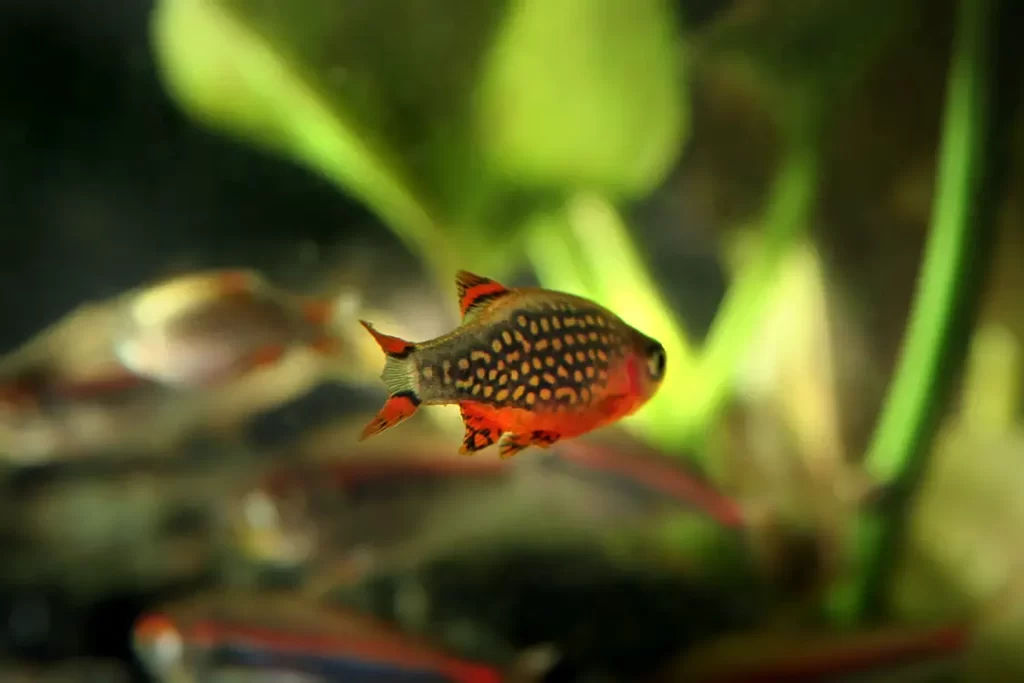
- Scientific name: Danio margaritatus
- Adult Size: Up to 0.6 inches (1.5 cm)
- Minimum Tank Size: At least 5 gallons, but larger tanks are recommended for a school of 6 or more individuals.
- Level: Beginners
- Compatibility: Peaceful and compatible with other small, non-aggressive fish such as other small rasboras, tetras, and shrimp. They may become stressed in the presence of aggressive or larger fish.
- Care Level: Moderate
- Water Temperature: 72-78°F (22-26°C)
- Diet: Omnivorous; they will eat various foods, including flakes, pellets, frozen or live foods such as brine shrimp or bloodworms, and small insects and crustaceans.
- Origin: Southeast Asia, specifically Myanmar (formerly known as Burma)
- Swimming Level: Middle to top of the aquarium; they are active and will swim in a shoal or school, often near the surface or middle of the tank.
Livebearers
Livebearers are fish known for their unique reproductive method of giving birth to live young instead of laying eggs. They are popular among aquarium enthusiasts because of their unique breeding behavior and colorful body patterns.
Some species, such as guppies, mollies, and platies, have bright and eye-catching colors like red, blue, orange, and yellow. Livebearing fish prefer an aquarium with plants and hiding spots to provide them with security and places to rest.
Additionally, livebearers live in communities, so it is recommended to keep them in groups to promote their natural social behavior. Now, let’s have a deep look at some of the livebearing fish suitable for betta tank:
Guppies (Feeder guppies or Female only)
People often choose feeder or female guppies to keep with bettas because they are smaller and not as flashy as male guppies. In addition, female guppies have shorter fins and less bright colors, so bettas are less likely to see them as competition.
Feeder guppies, being smaller and less fancy, also work well as tank mates for bettas. It’s important to have a clean and comfortable aquarium for these guppies, with the right temperature and enough places to hide, like plants or decorations.
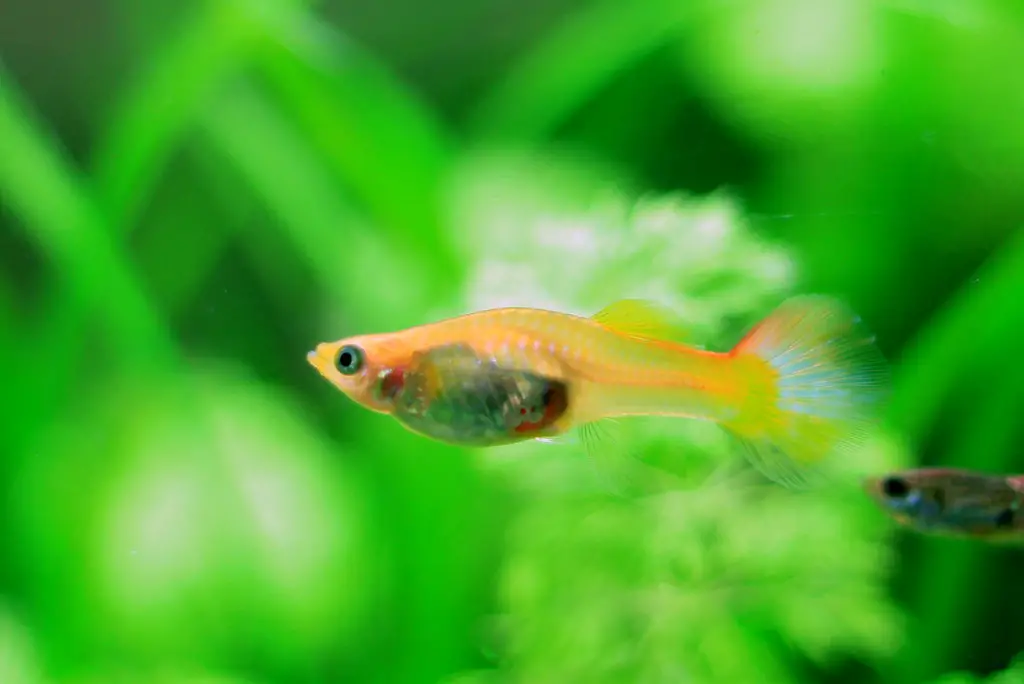
- Scientific name: Poecilia reticulata
- Adult Size: Males typically grow to around 1.5-2.5 inches (3.8-6.4 cm), while females can grow up to 2.5-3 inches (6.4-7.6 cm).
- Minimum Tank Size: At least 5 gallons for a small group of guppies, but larger tanks are recommended for larger groups or breeding populations.
- Level: Beginners
- Compatibility: Guppies are generally peaceful and can be kept with other peaceful community fish such as tetras, rasboras, and corydoras catfish.
- Care Level: Easy
- Water Temperature: 72-82°F (22-28°C)
- Diet: Omnivorous; guppies will eat various foods, including flakes, pellets, and live or frozen foods such as brine shrimp or bloodworms.
- Origin: Native to South America, specifically northeastern Brazil, Guyana, and Trinidad.
- Swimming Level: Middle to top of the aquarium; guppies are active and will swim throughout the tank, often near the surface.
Mollies
Mollies are colorful fish that are popular in aquariums. They have a slim and elongated body with a slightly triangular shapes. Mollies come in different colors, like black, white, orange, and silver. These fish need a clean and well-kept tank with good filtration and regular water changes. They also prefer some plants and decorative items as hiding spots in the tank.
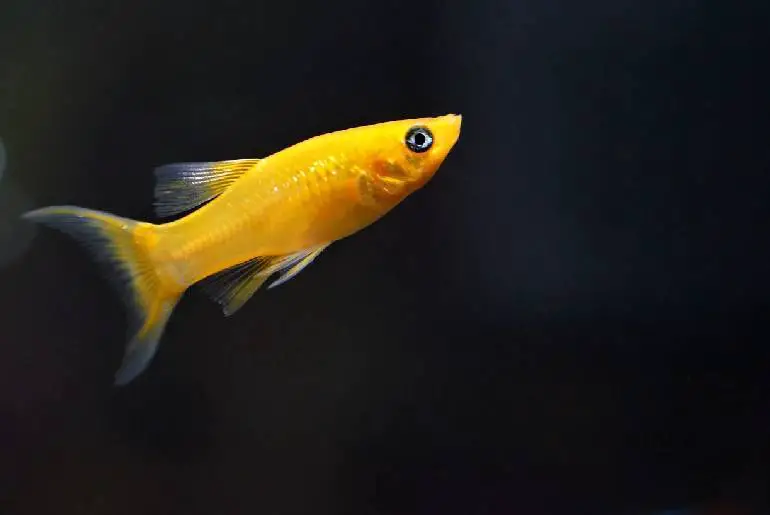
- Scientific name: Poecilia sphenops
- Adult Size: Mollies can grow up to 4-6 inches (10-15 cm) in length, although some smaller varieties stay closer to 2-3 inches (5-7.5 cm).
- Minimum Tank Size: A minimum of 20 gallons is recommended for a small group of mollies, but larger tanks are preferred for larger groups or breeding populations.
- Level: Beginners
- Compatibility: Mollies are generally peaceful and can be kept with other peaceful community fish such as tetras, rasboras, and corydoras catfish.
- Care Level: Moderate
- Water Temperature: 75-82°F (24-28°C)
- Diet: Omnivorous; mollies will eat various foods, including flakes, pellets, and live or frozen foods such as brine shrimp or bloodworms. They also appreciate some vegetable matter in their diet, such as blanched spinach or zucchini.
- Origin: Mollies are native to Mexico, Central America, and South America.
- Swimming Level: Middle to top of the aquarium; mollies are active and will swim throughout the tank.
Platies
Platies are known for their active and playful nature, making them a delightful addition to any tank. They have a rounded body shape and come in various vibrant colors like red, orange, yellow, and blue. Platies prefer a well-maintained tank with clean water, regular water changes, and a balanced diet. In addition, they enjoy having plants and decorations in their tank to provide hiding spots and places to explore.

- Scientific name: Xiphophorus maculatus
- Adult Size: 2.5 inches (6.4 cm)
- Minimum Tank Size: 10 gallons for a small group
- Level: Beginners
- Compatibility: Peaceful and compatible with other peaceful fish species
- Care Level: Easy to care for
- Water Temperature: 70-82°F (21-28°C)
- Diet: Omnivorous, will accept most commercial fish foods, but also enjoys live or frozen foods
- Origin: Central America and Southern Mexico
- Swimming Level: Mid-level
Other Species
Not only fish, but you can also add some compatible invertebrates as tank mates for your betta fish. Here, we will discuss some of the non-fish tank mates and fish species familiar with Betta fish regarding tank compatibility. They are as follows:
Amano Shrimp
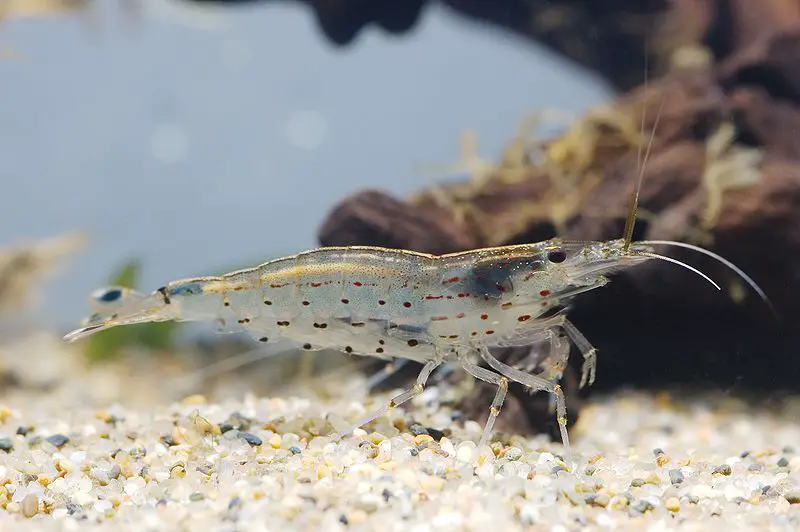
Amano shrimp are small freshwater crustaceans popular in aquariums for their unique appearance and beneficial behavior. They have a transparent body with a curved shape and long, delicate antennae. Amano Shrimp are popular for controlling algae and keeping tanks clean.
These shrimp species prefer aquariums with clean water and a stable temperature. Therefore, providing them with hiding places like plants and decorations is important to make them feel secure. They make great tank mates for bettas because they are peaceful and too big to be eaten by the Betta fish.
Also, Amano shrimp are hardy and easy to care for, making them a great addition to a betta tank. However, it’s important to note that these shrimp may not survive in tanks with high nitrate levels or aggressive tank mates.
Ghost Shrimp
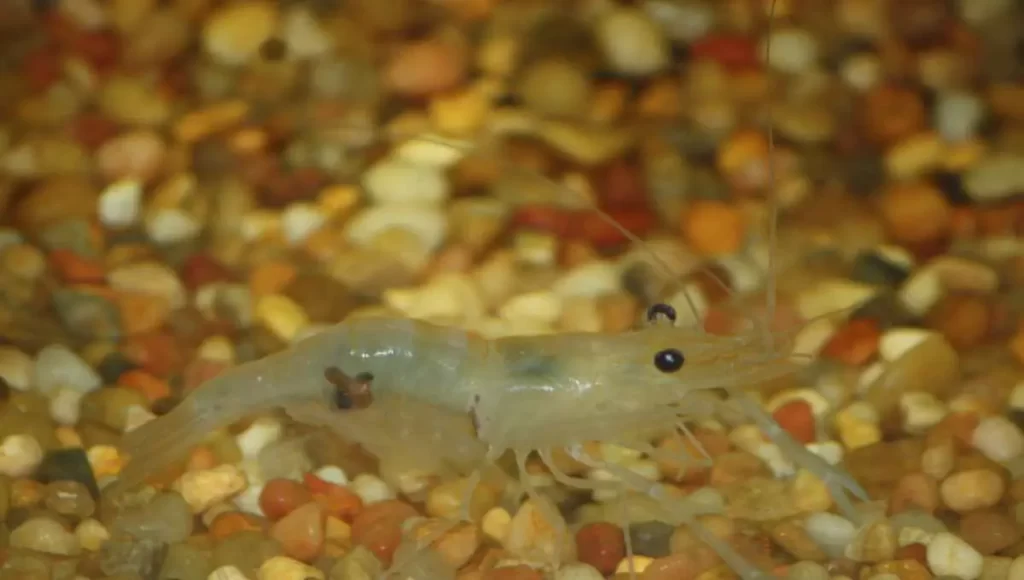
Ghost shrimp are also called glass shrimp too because of their transparent body. They have a translucent or semi-transparent body appearance. Ghost shrimp have a slender and elongated shape, long antennae, and multiple pairs of legs.
These shrimps blend in so well that they almost become invisible in the tank. If you’re looking for a good cleanup crew, ghost shrimps might be a great addition to your betta tank. These little guys are scavengers, always on the hunt for food. They prefer a well-filtered aquarium with clean water and a suitable temperature. Since they’re quite small, adding around 6-8 ghost shrimp to your tank is recommended.
Snails
Snails are small aquatic creatures known for their unique appearance and helpful role in the ecosystem. They have a soft body covered by a hard shells in various shapes and colors. Snails use their muscular foot to move around and feed on algae, decaying plant matter, and leftover food, helping to keep the tank clean.
They require a well-maintained aquarium with clean water and a suitable temperature. In addition, providing them with enough food and calcium-rich supplements is important for their health and shell development.

Mystery Snails
Mystery Snails are among the most popular snails you can find in pet stores. They come in various colors and patterns with dark textures and brown colors with stripes on their shells. These snails have a diverse diet that includes algae and dead or decaying plant matter. They play an important role in keeping your aquarium clean by consuming algae and helping to break down organic waste.
Assassin Snails
Assassin Snails are your helpful companions if you find unwanted snails in your planted aquarium. Sometimes, snails can accidentally make their way into your tank and start reproducing rapidly, becoming an issue. You can add these assassin snails to your tank as they are a natural and efficient solution to deal with snail overpopulation. These small snails have a distinctive spiral and pointed shell structure that adds a unique appearance to your tank.
Nerites Snails

Nerite snails are a popular choice among freshwater aquariums. These snails come in various shell shapes, colors, patterns, and textures, adding visual interest to your tank. One of the main reasons why Nerite snails are highly sought after is their exceptional algae-eating abilities. If you have a planted aquarium, you’ll often find at least a pair of Nerite snails diligently feasting on algae growth. Their appetite for algae helps keep the aquarium clean and balanced, contributing to a healthier environment for your fish and plants.
Gold Inca Snails
Gold Inca Snails, also known as apple snails, are excellent additions to your aquarium as they help keep the tank clean. These snails are quite popular and won’t cost you much. The main specialty of Gold Inca Snails is that they are efficient tank cleaners, as they feed on algae and leftover fish food, helping to prevent excessive buildup of organic waste. As a result, they play a significant role in maintaining a clean and balanced aquatic environment.
Zebra Danios
Zebra danios are small and active freshwater fish. They have a distinct appearance, with horizontal blue and silver stripes running across their slender body. These stripes resemble a zebra, hence the name “zebra danios.” Their streamlined shape and fins allow them to swim in the water.
They are perfect for beginners in fishkeeping because they’re so easy to care for. This aquatic creature prefers a well-lit tank with plenty of swimming space and some live plants for hiding. However, you should watch them, as they might nip at your betta’s fins and tail.
What Are the Fish Species That Are Not Compatible with Betta Fish?
Several fish species are not recommended to be kept with Betta fish, as they can be aggressive and territorial, leading to fights and stress for the Betta. Some fish species that are incompatible with Betta fish are:
1. Other male Betta Fish

Male Betta fish are known for their territorial and aggressive nature and tend to establish their territories within the aquarium. When two male Bettas are placed together, they often engage in aggressive behaviors such as flaring, chasing, and even physical fighting. This can result in severe stress, injuries, and even death for one or both of the Bettas.
2. Angelfish
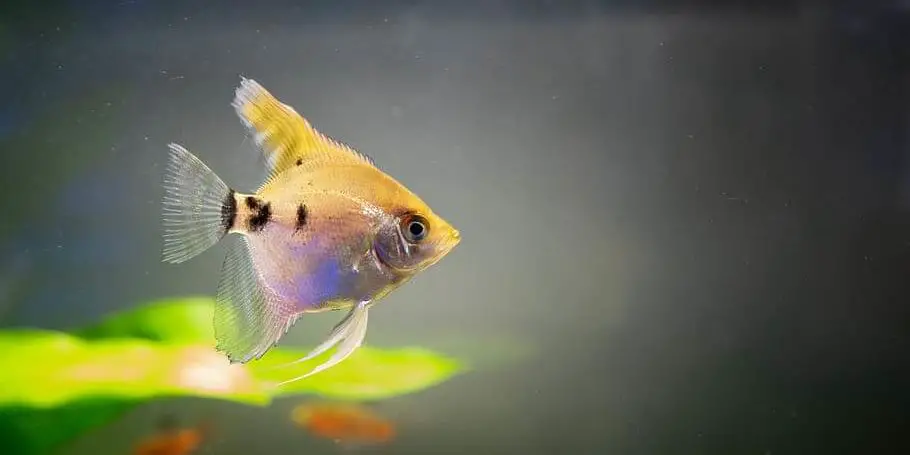
While not all Angelfish are aggressive, some individuals may exhibit territorial tendencies, especially when they feel threatened or stressed. The interactions between these two fish can result in injuries or stress for the Betta fish. If you plan to keep Angelfish and Betta fish together, close monitoring is necessary to ensure that both species coexist peacefully.
3. Cichlids

Cichlids are well-known for their aggressive behavior and can be quite hostile toward Betta fish, leading to stress and harm for the Betta. For example, species like the Convict Cichlid or the Jack Dempsey Cichlid are known for their highly aggressive nature and are not suitable tank mates for Betta fish.
You should prioritize the safety and well-being of the Betta fish, so avoid keeping Cichlids and Bettas together in the same tank and prevent any potential fights or harm.
4. Goldfish
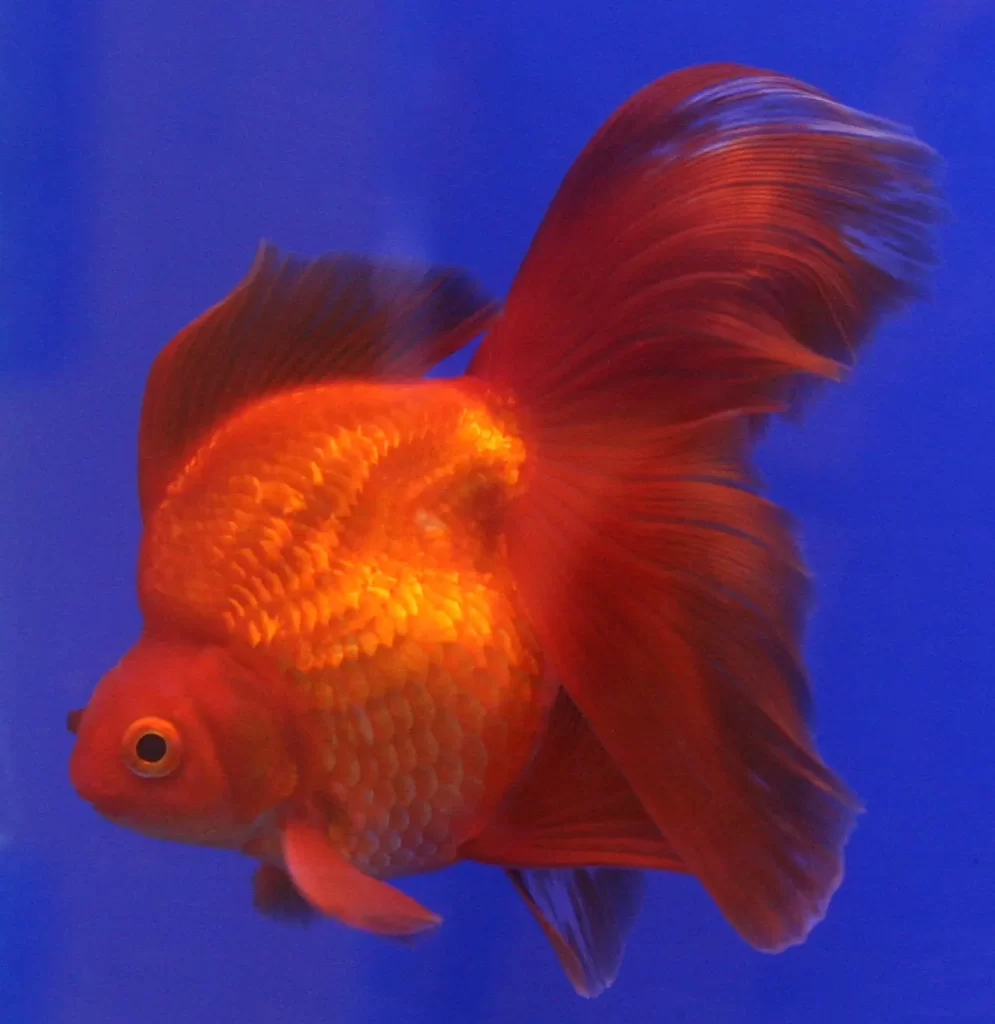
Goldfish and Betta fish have different temperature preferences, as goldfish live in cooler water while Betta fish prefer warmer water conditions. Therefore, keeping them together in the same tank may lead to a compromised environment for one or both species.
Goldfish bite the long fins of other fish, including Betta fish. This can stress out the Betta fish and cause harm to their delicate fins
5. Gouramis
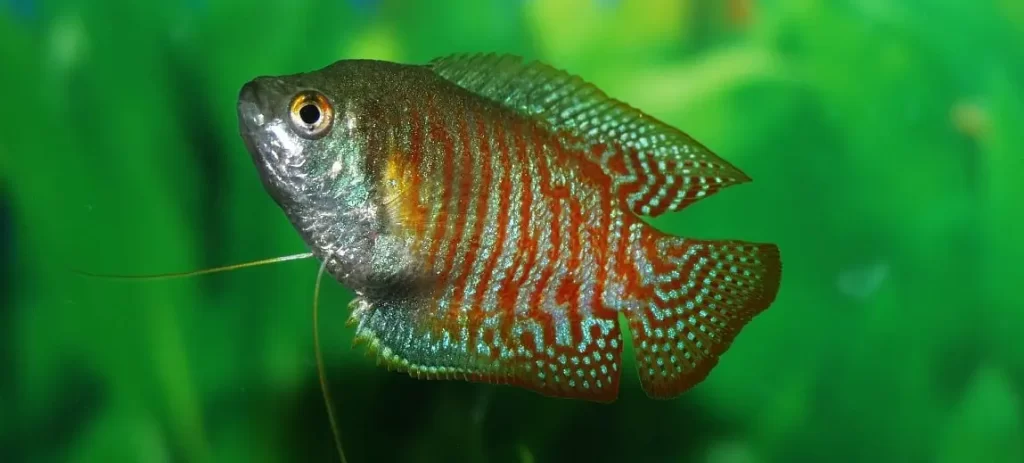
Gouramis are similar in appearance to Betta fish and may be mistaken as suitable tankmates, but they can be aggressive toward Bettas and should not be kept together.
While some species of Gouramis, like the Dwarf Gourami, are generally peaceful, other species, such as the Three-Spot Gourami, can be territorial and display aggressive tendencies. These aggressive behaviors can include chasing, fin-nipping, and even physical attacks.
6. Puffers
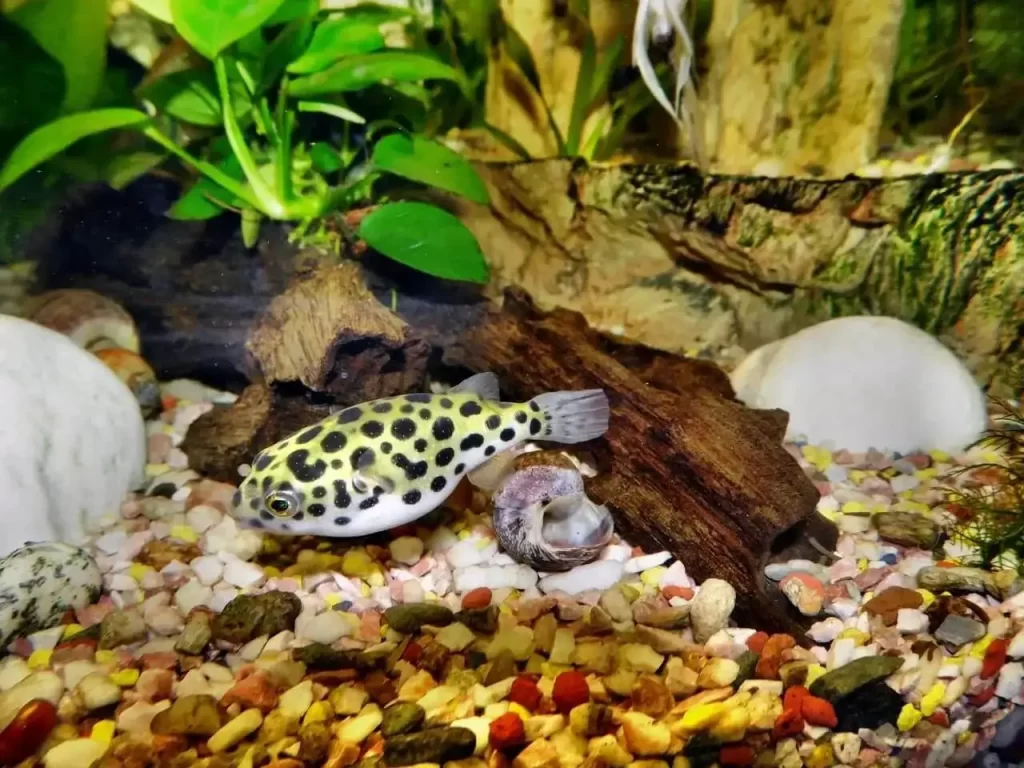
Puffers are known for their territorial behavior and aggressive tendencies and may view Bettas as a threat or competition. In addition, some puffers have sharp beak-like mouths that they use to eat hard-shelled prey. These beaks can hurt the delicate fins of Betta fish.
For example, species like the Figure Eight Puffer or the Green Spotted Puffer are known to be territorial and should not be kept with Bettas.
What Are The Recommended Items To Include In A Betta Fish Tank?
There are a few essential items that you should include to ensure that your Betta fish is healthy and happy in a tank. So, here are some recommended items to include in a Betta fish tank:
Filter
A filter is crucial in your betta fish tank, as it helps keep the water clean and free of harmful toxins. When choosing a filter for your betta fish tank, it’s important to remember that Bettas prefer calm water. So, a gentle filter is the best option to avoid disturbing your betta’s peaceful environment.
Heater
Bettas are tropical fish and prefer their water to be between 76-82 degrees Fahrenheit. To achieve this, a heater is essential for your Betta tank setup. A heater can maintain a stable and suitable temperature for your fish to survive.
Substrate
Bettas are known for their love of swimming in the top and middle of the tank, but they occasionally explore the bottom of the tank. So, provide a substrate that won’t damage their delicate fins or hurt their sensitive organs. Smooth gravel or sand are great options that won’t harm your Betta’s delicate body.
Plants
Bettas tend to prefer soft, broad-leaved plants like Anubias and Java Ferns. Live or silk plants are excellent for their tank as they create a natural-looking habitat for your fish and offer hiding spots. These plants also balance oxygen levels in the water, which is essential for the health of your fish.
Decoration
Decorations are a great way to add personality to your Betta’s tank while also providing hiding places for them. Caves and driftwood can create a natural-looking environment that Bettas love. However, it’s essential to ensure that any decorations are safe for your Betta and won’t tear their delicate fins.
Water Conditioner
A water conditioner is designed to neutralize these chemicals, making the water safe for your Betta. It binds with chlorine and chloramine molecules, making them harmless. You must add a few drops of water conditioner to aquarium water to ensure the water is safe for your fish. The water conditioner removes these harmful chemicals and makes the water safe in your Betta’s tank.
What Are The Signs Of Compatibility Or Incompatibility Between Betta Fish And Other Species?
Betta fish can display various signs and symptoms that indicate compatibility or incompatibility with other fish species in the same aquarium. Here are some of the most common signs to look out for:
Signs of Compatibility
Betta fish display specific signs that indicate compatibility with other fish in the tank. Here are some signs of compatibility:
Peaceful Coexistence
If your Betta fish is peacefully coexisting with other fish species in the tank, it’s a positive indication of compatibility. Watch for behaviors such as swimming together, peacefully sharing food, or ignoring each other. These signs suggest that the Betta and its tank mates are progressing well.
Minimal Aggression
While Bettas are known for their territorial behavior, they should not be overly aggressive towards other fish in the same tank. Occasional displays of aggression, such as flaring their fins or chasing other fish, are normal, but constant aggression is a sign of incompatibility.
Active And Alert
Bettas comfortable with their tank mates tend to be more active and alert. They confidently explore the tank, swim around, and show curiosity about their surroundings. This behavior indicates positive compatibility with their fellow fish.
Healthy Appearance
If your Betta is healthy, with bright colors and intact fins, it’s a good sign that they are compatible with their tank mates. Conversely, stress or illness caused by incompatibility can lead to dull colors, damaged fins, and other health issues.
Sign Of Incompatibility
Certain signs indicate incompatibility between Betta fish and their tank mates. These signs can help you identify when there may be issues or conflicts in the aquarium. It’s important to pay attention to these signs for the well-being of all the fish in the tank. Some of the common signs of incompatibility are:
Aggression
Aggression is a clear sign of incompatibility between Betta fish and their tank mates. If you notice your Betta constantly attacking or chasing other fish, it indicates they are not getting along. This aggression can be directed toward a specific fish or exhibited toward all the tank mates.
Hiding Or Avoidance
When Bettas feel uncomfortable or stressed around other fish, they may hide in plants or decorations or swim away to avoid interaction. This behavior indicates they are uncomfortably coexisting with their tank mates and may prefer to be alone. If you want to learn more about Why Betta Fish Hide, you can check out the other article where I have written possible reasons for their hiding behavior and the solutions.
Damaged Fins Or Other Injuries
Damaged fins or other injuries on your Betta fish can indicate incompatibility with their tank mates. If you notice torn or frayed fins, it may result from nipping or aggressive behavior from other fish in the tank. This can cause stress and harm to your Betta.
Stress Or Illness
Incompatible tank mates can make Betta fish stressed or sick. Signs of stress or illness in Bettas include being less active, not eating properly, and showing changes in color or behavior. You should seek a veterinarian or separate the fish from others, as some illnesses can lead to death.
How Can I Meet My Betta’s Needs?
Betta fish have specific needs regarding their environment, diet, and general care. Meeting these needs can help ensure your Betta is healthy, happy, and thriving. Here are some tips on how to meet your Betta’s needs:
Provide A Suitable Environment
Betta fish need a tank with a minimum size of 5 gallons and a heater to maintain a temperature between 78-82°F. They also need a filter to keep the water clean and aerated and plenty of hiding places, such as plants or decorations.
Offer A Proper Diet
A balanced diet for Betta fish typically consists of high-quality pellets specifically formulated for their nutritional needs. In addition, you can supplement their diet with frozen or live foods like brine shrimp or bloodworms and occasional treats like small pieces of cooked vegetables or fruits. These foods will give them additional nutrients and mimic their natural feeding habits.
Keep The Water Clean
Betta fish are sensitive to poor water quality, so it’s important to perform regular water changes to keep the tank clean and healthy. Aim for a 25% water change once a week, and use a water conditioner to remove chlorine and other harmful chemicals.
Monitor Their Health
Keep an eye on Betta’s behavior, appearance, and appetite. These changes can be signs of a health issue that needs attention. Watch out for things like decreased activity, unusual swimming patterns, loss of color, or decreased appetite. If you notice any of these changes, it’s important to investigate further and take appropriate measures to ensure your Betta’s well-being.
Provide Stimulation
Betta fish are smart and curious fish that love to have fun. To keep your Betta happy, add decorations or toys to their tank that encourage them to play and explore. For example, you can place some floating plants for them to swim around or add small caves and tunnels to hide in. Another idea is to include a gentle flow of water using a bubbler or air stone, which can create movement and interest in the tank.
Frequently Asked Questions(FAQs)
Here are some of the frequently asked questions about the tank mates for Betta fish, and they are as follows:
How Many Tank Mates Can I Add To My Betta Fish?
There isn’t an exact number of tank mates that can be added with a betta fish, as it depends on factors such as the aquarium’s size, the betta’s temperament, and the compatibility of the potential tank mates.
Can Betta fish be kept with other Betta fish in the same tank?
Male Betta fish should not be kept together in the same tank as they will fight and can even kill each other. Female Betta fish can sometimes be kept together in larger aquariums with plenty of hiding spots. Still, monitoring their behavior and separating any fish showing aggression is important. It’s usually best to keep Betta fish alone or with peaceful community fish.
Conclusion
Betta fish are pretty solitary creatures and don’t necessarily need tank mates. But if you want to add some friends to the mix, just be sure to do your research and choose compatible species. Of course, you want to avoid fighting or overcrowding in your tank!
So, I’ve had some luck adding fish to my betta’s tank as tank mates, including neon tetras, corydoras catfish, and snails. They’ve all coexisted peacefully, but it’s important to remember that not all fish get along with bettas.
And if you have any success stories with your betta tank mates, I’d love to hear about them! It’s always great to share tips and tricks with fellow aquarium enthusiasts.

